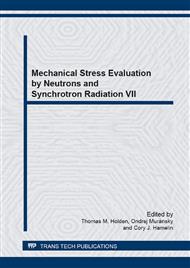p.118
p.124
p.130
p.136
p.142
p.148
p.155
p.161
p.165
Crystal Plasticity Finite Element Analysis Based on Crystal Orientation Mapping with Three-Dimensional X-Ray Diffraction Microscopy
Abstract:
In other study we examined the plastic behavior for polycrystalline iron by three-dimensional x-ray diffraction (3DXRD) experiment. In this study we analyze the behavior by crystal plasticity finite element (CPFE) analysis, to confirm the validity of application to the deformation analysis of engineering steels of a couple of constitutive models. In the CPFE analysis, the observed microstructure and its crystal orientation are modeled with finite elements to take the inter-granular and intra-granular interactions into consideration. The plastic deformation state of the finite element model was computed by means of CPFE analysis based on the {110}<111> slip system in body centered cubic (BCC) crystal. The experiment showed that the most of the grains rotated toward the preferred orientation <110> along the tensile axis and that intra-granular orientation spread and multi-directionally rotated as the tensile strain increased. These results are reproduced by the CPFE analysis, in which the influence of interaction between neighboring grains is taken into consideration.
Info:
Periodical:
Pages:
142-147
Citation:
Online since:
February 2014
Authors:
Price:
Сopyright:
© 2014 Trans Tech Publications Ltd. All Rights Reserved
Share:
Citation:


